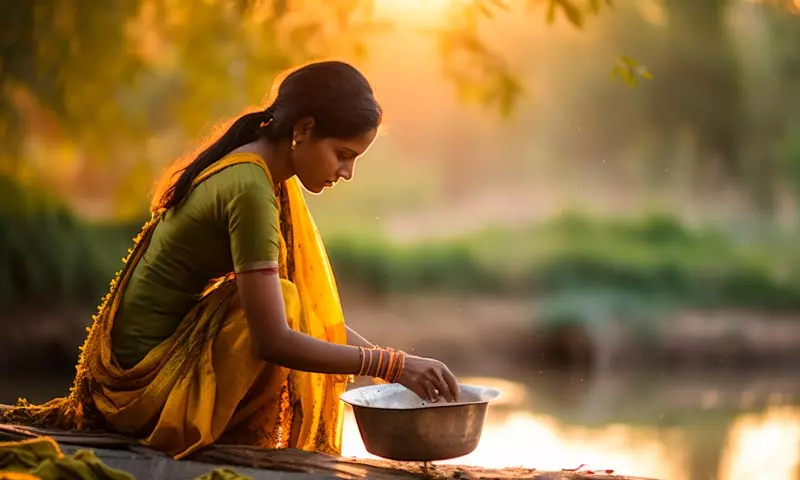Imagine wearing a garment that not only drapes you in beauty but also heals your skin, soothes your mind and shields you from invisible harms. This is the magic of Ayurvastra—the ancient Indian tradition of life-infused cloth dyed with nature’s own medicine.
A Fabric Born from the Heart of Ayurveda
Ayurvastra—a Sanskrit word meaning “life cloth”—is more than just fabric. It is a living legacy of Ayurveda, the 5,000-year-old Indian science of life and holistic healing. While modern textiles rely on synthetic dyes and chemicals, Ayurvastra harnesses the power of sacred herbs and plants to breathe life, health and spirit into every thread.
Picture cotton or silk kissed by the golden glow of turmeric, steeped in the earthy essence of neem or bathed in the sacred waters of tulsi (holy basil). These are not random ingredients—they are revered healers in Indian tradition, each carrying potent properties:
- Neem: The “village pharmacy” — antibacterial, antifungal and purifying
- Turmeric: The golden spice of life — anti-inflammatory, cleansing and uplifting
- Tulsi: The holy basil — spiritual protector and stress reliever
The fibers absorb these gifts from nature, transforming simple cloth into an ancient remedy you wear on your skin.
The Ritual of Making Ayurvastra
Creating Ayurvastra is a sacred dance between artisan and earth. First, medicinal plants are carefully harvested, often at specific times of day to capture their peak potency. These herbs are crushed, boiled and brewed into rich, fragrant dyes.
Next comes the fabric—usually pure cotton or silk—immersed repeatedly into herbal baths, soaking up layers of healing color and essence. The cloth dries under the sun, absorbing the earth’s warmth and energy while artisans hum prayers and songs, weaving intention and blessing into the fibers.
No synthetic chemicals mar this process. No shortcuts. Only time, patience and respect for nature’s rhythm.
Historical Insights
- Royal Patronage: Ayurvastra was historically patronized by Indian royalty. Kings and queens wore garments dyed with medicinal herbs like turmeric and neem to promote health and protect against ailments.
- Martial Use: In ancient times, warriors wore Ayurvastra garments under their armor. These garments were believed to aid in healing wounds and preventing infections during battles.
- Traditional Weaving Centers: Balaramapuram in Kerala is renowned for its Ayurvastra textiles. The region’s handloom industry, established in the early 19th century, specializes in producing these medicinal fabrics.
Stories Stitched in Every Thread
Folklore whispers that Ayurvastra was once worn by sages and kings, who understood the power of nature’s colors to balance mind, body and spirit. Robes dyed in these sacred herbs were said to protect against diseases, ward off evil spirits and even prolong life.
- Healing Garments for Newborns: In some South Indian traditions, newborns are wrapped in Ayurvastra cloths dyed with herbs like turmeric and neem. These garments are believed to protect the infants from infections and promote overall well-being.
- Siddha Contributions: The Siddha tradition, closely related to Ayurveda, contributed significantly to Ayurvastra. Siddha practitioners, including the revered sage Agastiyar, formulated herbal dyes and promoted their use in textiles.
One tale tells of a weaver struck by illness. Desperate, he dyed his cloth with neem leaves from a sacred grove. As he wore the fabric, his fever eased, his skin cleared and peace returned to his soul. From that day, Ayurvastra became known as the “medicine you wear.”
Modern Applications and Benefits
- Therapeutic Properties: Studies have shown that Ayurvastra fabrics can alleviate symptoms of eczema, psoriasis and rheumatism. The herbal dyes possess antimicrobial and anti-inflammatory properties.
- Sustainable Fashion: Ayurvastra aligns with contemporary sustainable fashion trends. By using natural dyes and eco-friendly processes, it offers an alternative to synthetic textiles that are harmful to both health and the environment.
Pima Prima & Ayurvastra Today
Just as Ayurvastra brings life and healing to cloth, Pima Prima’s use of natural dyes in extra-long staple Pima cotton ensures your T-shirt cares for your skin and the planet. Wearing a Pima Prima T-shirt is not just a fashion choice—it is a mindful act that honors centuries of textile wisdom while supporting sustainable practices.
Every Pima Prima garment carries subtle earthy hues inspired by Ayurvastra herbs, bridging ancient healing traditions with modern wellness. You wear more than a T-shirt—you wear a connection to culture, nature and care.
Why You Should Wear Ayurvastra or Pima Prima
- Health Benefits: Natural antimicrobial and anti-inflammatory properties help protect and soothe your skin
- Eco-Friendly: No toxic dyes or chemicals, only sustainable herbal ingredients
- Cultural Connection: Carry centuries of Indian wisdom and spirituality wherever you go
- Unique Beauty: Each piece carries the subtle, earthy hues of the herbs and the hands that made it
The Living Legacy of Life Cloth
Ayurvastra reminds us that clothing can be more than just fabric. It can be a bridge between nature and human wellbeing—a soft armor of health, beauty and tradition woven into every fiber. Next time you choose what to wear, imagine draping yourself in a thousand years of healing knowledge—cloaked in the sacred colors of earth and life. Wearing Pima Prima naturally dyed cotton lets you carry that legacy with style, comfort and care.








